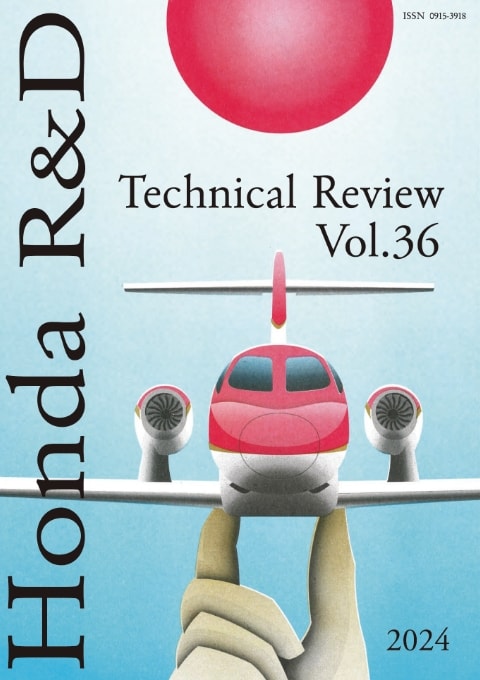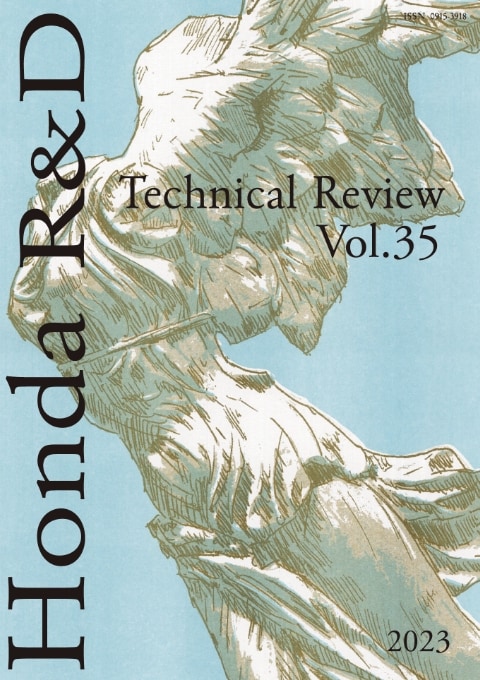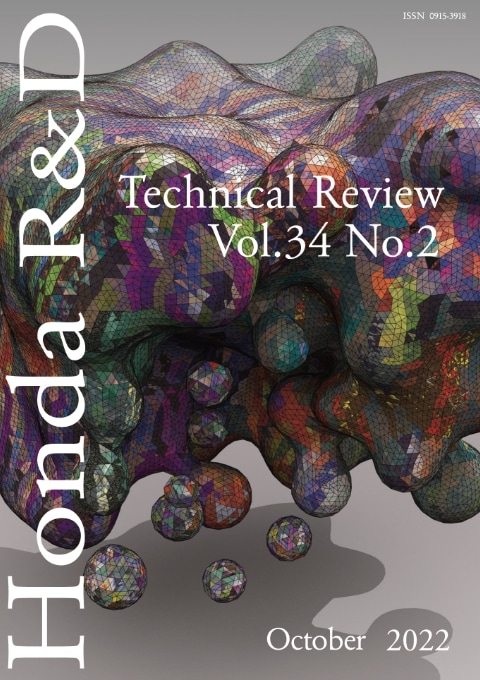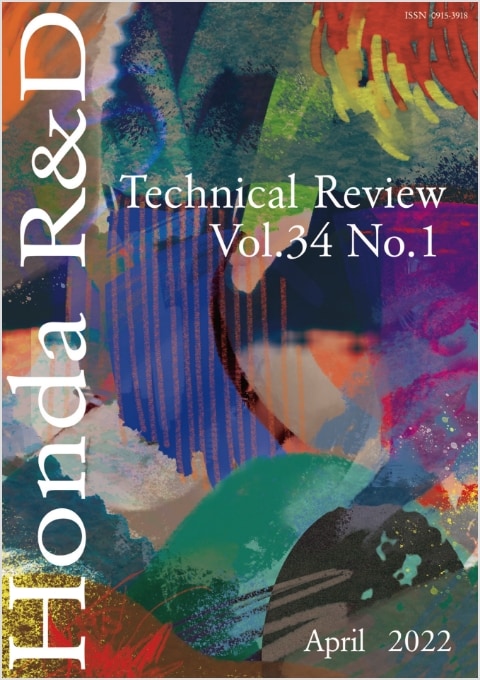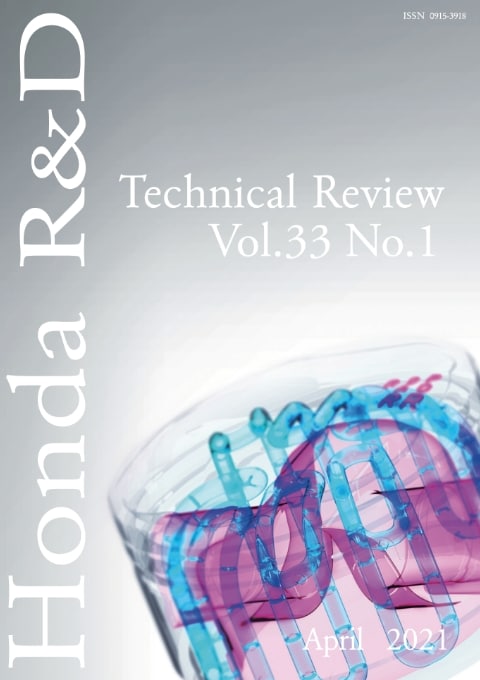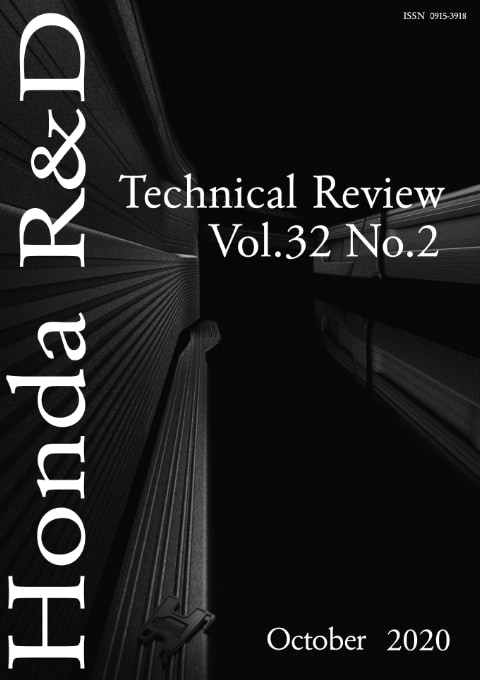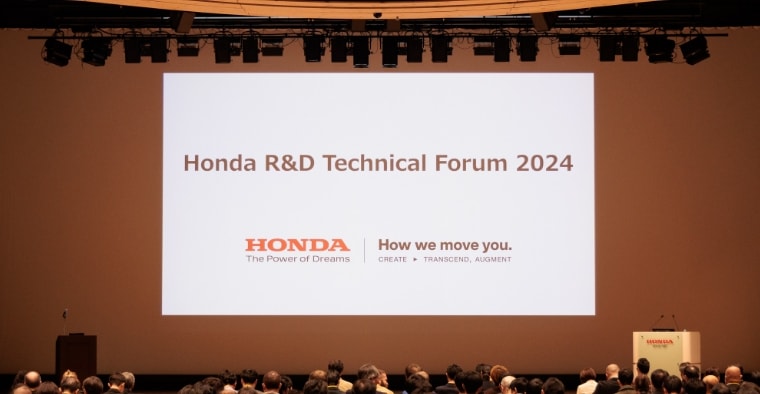Honda R&D Technical Review Vol.33 No.1
Honda R&D
Technical Review Vol.33 No.1
- Development and Styling Design of Airport Guide Robot System
- Summary
In an effort to create “a robot that coexists and cooperates with people and performs useful functions in society,” the concept of a “Compass to Accompany” was formulated during the development of a robot system to provide a guide service inside an airport facility as one public space in which individuals are coming and going. A questionnaire was administered to airport staff and to families of Honda employees, and a design was brought to fruition that entails identifying a potential request while listening to a live voice. Thorough consideration was given to enhancements to driving mechanisms and to the feasibility of various types of sensors associated with advancements in development; mockups and prototypes were obtained; and reception and guide robots were realized as easy to talk to, functional designs.
Development efforts yielded an interface that guests can use without confusion and a feature capable of performing guided movement in the same manner as a human, even in an environment crowded with pedestrians, confirming the potential of offering a service consistent with this concept in an actual airport setting.Yoko SAITO、Takeshi KOSHIISHI
Details of papers - Development of Reception Robot for Airport Guidance
- Summary
We proposed a novel guide robot system that uses robots to provide guidance at Narita International Airport. The system implements the guidance through collaboration between robots having two different service roles: a reception role and a guide role. The reception robot greets guests, shows the route to a destination identified by a guest through voice and touch-screen input, and, by means of the Guide Robot Management System, communicates the destination to the guide robot. As this reception robot was developed, the concept of “Compass to Accompany” in the guide robot system was implemented through the functions of universal design (multilingual support and height adjustment), impasse-free dialogue (voice recognition and dialogue engine), and natural responses from the robot (motion, sound, and display). In user evaluations, 80% of survey participants indicated that they would like to try using the system if it becomes available at an airport.
Junya ONISHI、Ayako MASUDA、Chihiro OBAYASHI、Yuichi KAWASAKI、Yuki TAKEBE
Details of papers - Research of Robust Follower Recognition Function for Airport Guide Robot
- Summary
Hospitality is a key factor for the success of guide robot service. This paper defines a new recognition function called follower recognition, and proposes a hybrid approach to realize the follower recognition function. This approach creates a fusion of facial recognition, human body tracking, and person re-identification algorithms and takes advantage of the respective technological characteristics to realize robust follower recognition against issues such as recognition distance change, illumination change, and occlusion from the robot’s perspective. The proving test result at Narita International Airport showed that the proposed approach is practical in guide robot service.
Zijun SHA、Yoichi NATORI、Takahiro ARIIZUMI
Details of papers - Coloring Design for 2020 CRF1100L Africa Twin
- Summary
In 2016, Honda revived the iconic Africa Twin with three color schemes: Tricolor (red/blue/white), CRF Rally (red/black/white), and monotone (black, silver). Instead of being simple color variations, they create distinctive moods for the respective models with differing primary usage. The 2020 model has two versions: the Africa Twin with enhanced off-road riding experience, and the Africa Twin Adventure Sports with enhanced comfort for touring. In considering the color schemes, we sought to express a deeper worldview of the iconic model by linking each color scheme to its own characteristics and the model’s heritage.
Midori KATSURAGAWA
Details of papers - Active Sound Control Technology for Electrified Vehicles Based on Concept of Shepard Tones
- Summary
Active Sound Control technology for electrified vehicles was developed in order to realize vehicle interior sound levels matching the seamless acceleration that is characteristic of driving under electric motor power. This technology takes the fundamental approach of generating sound based on the conceptual approach of Shepard tones and synchronizing it with the vehicle velocity. The main tones generated according to the theory of Shepard tones are superimposed with multiple sub-tones at preset frequency ratios. This approach can produce acceleration sounds with further increased freedom. An acceleration sound that differs from engine sound and has sounds matched to the electrified vehicle has been realized by means of this technology.
Xun WANG、Takuma MAESAKA、Toshio INOUE
Details of papers - Technology for Prediction of Contactor Noise for Electric-powered Vehicle Batteries
- Summary
Electric-powered vehicles have a high-voltage battery unit mounted in the vehicle body, and the sound made by operation of the electromagnetic contactor inside the unit can be unpleasant for vehicle occupants. A method was created for predicting this noise from the excitation force of the high-voltage battery unit on its own and from the acoustic transmission characteristics of the vehicle body structure. The adoption of component-based transfer path analysis made it possible to separate vibration sources from transfer systems and predict noise in the fully assembled vehicle state by using the load transferred from the stand-alone high-voltage battery unit to the vehicle body side and a transfer function that combines the vehicle body structure transfer and the cabin acoustic transfer. A computer-aided engineering model was also created for predicting the load from the stand-alone high-voltage battery unit based on the load from the junction board, which is a sub-unit of it. This made it possible to predict the excitation force of the high-voltage battery unit at the drawing stage. By means of the above technology, it has become possible to consider noise evaluation in the fully assembled vehicle state at the performance design stage.
Akito SHIMOMURA、Naoki TOYAMA、Masamichi KAWABE、Yoshimi SATO
Details of papers - Proposal and Verification of Friction Coefficient Calculation Model by True Contact and Oil Film (Evaluation of Piston Ring and Sleeve)
- Summary
The investigation of sliding parts takes into account the coefficient of friction of the parts. When the parts are in a relatively high-speed region, such as the piston rings and sleeves in an engine, sliding test performance itself is a challenge and the tribological properties cannot readily be determined. Therefore, surface roughness and waviness after initial familiarity were applied to a stochastic method proposed by Liu, et al., and the oil film thickness reduction coefficient of Gupta, et al., was used in high-speed regions. In addition, a new calculation model was proposed that takes into sliding, which becomes a determining factor in higher-speed regions. As conventionally performed, sliding tests could not readily be implemented in high-speed regions. However, a newly developed drum cam test apparatus has made such testing possible to implement. The validity of this model was verified by comparison and the results of sliding tests up to 8 m/s. The results verified that the coefficient of friction in this model match very closely with the results of tests using ordinary sleeve material of cast gray iron (FC250) in high-speed regions up to 8 m/s. In addition, it has become possible to obtain the coefficient of friction in high-speed regions, which had not been possible to determine up to now. It has also become possible to predict the coefficient of friction in high-speed regions where the velocities are equal to or higher than in the verification tests.
Hideharu KOGA、Kenji MATSUMOTO、Yuki ONO
Details of papers - Heat Pipe with High Heat Transfer Rate by Reciprocating Motion (Examination of Application to Automotive Engine Piston)
- Summary
The flow of gas and liquid in heat pipes is generally impaired by factors such as oscillation and inclination, with the result that the heat transfer becomes excessively low. For this reason, there are no known cases of heat pipe use in cars and motorcycles, etc.
The authors, therefore, proposed a new heat pipe that controls the two-phase flow of gas and liquid without reducing the amount of heat transport, by reducing the friction energy loss inside the pipe and forcibly inducing self-oscillation.
Measurement results in the condition with oscillation applied by reciprocating motion showed an increase in the heat transfer coefficient by a factor of 1.6 compared with that at standstill. That mechanism is thought to be as follows. In the initial stage, the liquid sealed in the heat pipe is broken up into fine droplets by reciprocation. The droplets then acquire drive force in a constant direction macroscopically while contacting the gates, producing a unidirectional flow. Further, a loop flow channel enables transfer of gas and liquid from condensed areas to evaporation areas without gas-liquid collision.
This study performed thermal analysis of the case when applied to an engine piston. The results showed that the temperature at the piston head center was reduced by 39 K and DT was also reduced from 140 K to 75 K, and thus thermal stress reduction effects can be anticipated.Kenji MATSUMOTO
Details of papers - Reduction of Internal Resistance in High Capacity Lithium-ion Batteries with 3D Lattice-structured Electrode
- Summary
After applying a 3D metal lattice structure to the current collectors, enhancements to the cathode were examined in small cells, and an increase in volumetric energy density was demonstrated in laminated cells, with the goal of increasing the energy density of lithium-ion batteries.
Countermeasures were implemented to address two issues with the cathodes of small cells. The efficacy of these measures was confirmed, and the causal factors were cataloged. The first issue is enhancing the contact between the collectors and the active materials. This was addressed by coating the surface of the collectors with conductive carbon. The second issue is enhancing the creation of electron-conductive paths. This was addressed by applying a fine particle conductive agent in the form of a liquid dispersant. The results confirmed that each of these countermeasures had the effect of suppressing resistance and enhancing durability. Moreover, to ascertain the primary cause of these effects, the conductivity of the active material was evaluated using scanning probe microscopy (SPM). The results showed that it is because the countermeasures are suppressing the interruption of electron-conductive paths.
Increasing the thickness of the electrodes in laminated cells reduced the number of electrode layers, and resulted in a 9.8% increase in energy density of cell elements for a cell using 3D lattice-structured electrodes (674 Wh/L), compared with a cell using foil-coated electrodes (614 Wh/L).Kiyoshi TANAAMI、Toshimitsu TANAKA、Yuji ISOGAI、Shintaro AOYAGI、Akihisa HOSOE、Hiroshi TAKEBAYASHI、Kazuki OKUNO、Takuma YAMAMOTO
Details of papers - High Performance Si Negative Electrode Composed of Silicate Inorganic Binder
- Summary
Use of a silicate inorganic binder was investigated with the goal of suppressing volume expansion of Si negative electrodes associated with charge-discharge.
Use of a Si negative electrode with the electrode density lowered by conductive carbon and with inorganic binder permeated to the electrode interior enabled control of the amount of electrode expansion associated with charge-discharge and suppression of delamination from the current collector and conductive path breakdown within the active material layer. This realized a high-performance Si negative electrode with a large reversible charge-discharge capacity.
XPS analysis and STEM-EDX analysis were performed to elucidate these factors. The results showed that in electrodes coated with an inorganic binder, a network of siloxane bonds formed and strong bonds were obtained, and an interface phase in which the Si and inorganic binder are fused also formed.Makiko TAKAHASHI、Tomohiro KINOSHITA、Kiyoshi TANAAMI、Shintaro AOYAGI、Takashi MUKAI、Yuta IKEUCHI、Taichi SAKAMOTO、Naoto YAMASHITA
Details of papers - Oxidation Potential and Absolute Hardness Relationship in Lithium-ion Battery Electrolytes
- Summary
In this paper, we investigated the increase in oxidative stability of electrolytes in order to respond to the high-voltage operation of Li-ion rechargeable batteries. DFT geometry optimization calculations were performed for those molecular models of which side chain in the carbonate solvent substituted with a fluorinated alkyl group and the carbon in the main chain substituted with sulfur or oxygen. Linear correlation was found between the absolute hardness calculated from the frontier orbital energy following structural optimization and the oxidation potential determined by linear sweep voltammetry. Taking absolute hardness as an index, a mixed solvent of fluorinated alkyl ether and sulfolane, which was predicted to have better oxidative stability than carbonate solvent, was prepared as a prototype electrolyte. We then measured discharge capacity retention by a cyclic charge-discharge test using a battery with LiNi0.5Mn1.5O4, which is a well-known cathode material for high-potential operation. The result showed that the number of cycles taken to reach a discharge capacity retention index of 80% increased from 45 cycles, which is the figure when using carbonate electrolyte, to 80 cycles, which is the prototype.
Yoshiyuki MORITA、Hiroto MAEYAMA、Atsushi FURUKAWA
Details of papers - Predictive Technique for Seat Belt Submarining Injury by Triaxial Iliac Load Cell
- Summary
Submarining is one of the confirmation items in the frontal crash test, and if signs of submarining can be grasped with a single crash test, it will contribute to increasing the development efficiency of crash safety performance. This study created a prototype of a triaxial iliac load cell for an anthropomorphic test device and devised a method for calculating the position change of the acting point of the seat belt restraint load applied to the front end of the ilium, as a sign of submarining. In frontal crash sled tests that intentionally generated submarining, the acting point of the load applied to the ilium was observed to move upward from the front end of the ilium in the time zone before submarining occurred. As a result, this enabled to detect the signs prior to the occurrence of submarining.
Kazunori MAEHARA、Masahiro FUSHIMI、Tetsuhiro ARIMA、Shigeo ITO、Hidenori MIKAMI
Details of papers
- About Honda R&D
- Honda Philosophy
- Top Message
- Mission
- Organization
- Company Overview and Affiliates
- Members
- Award
- R&D Research Paper




